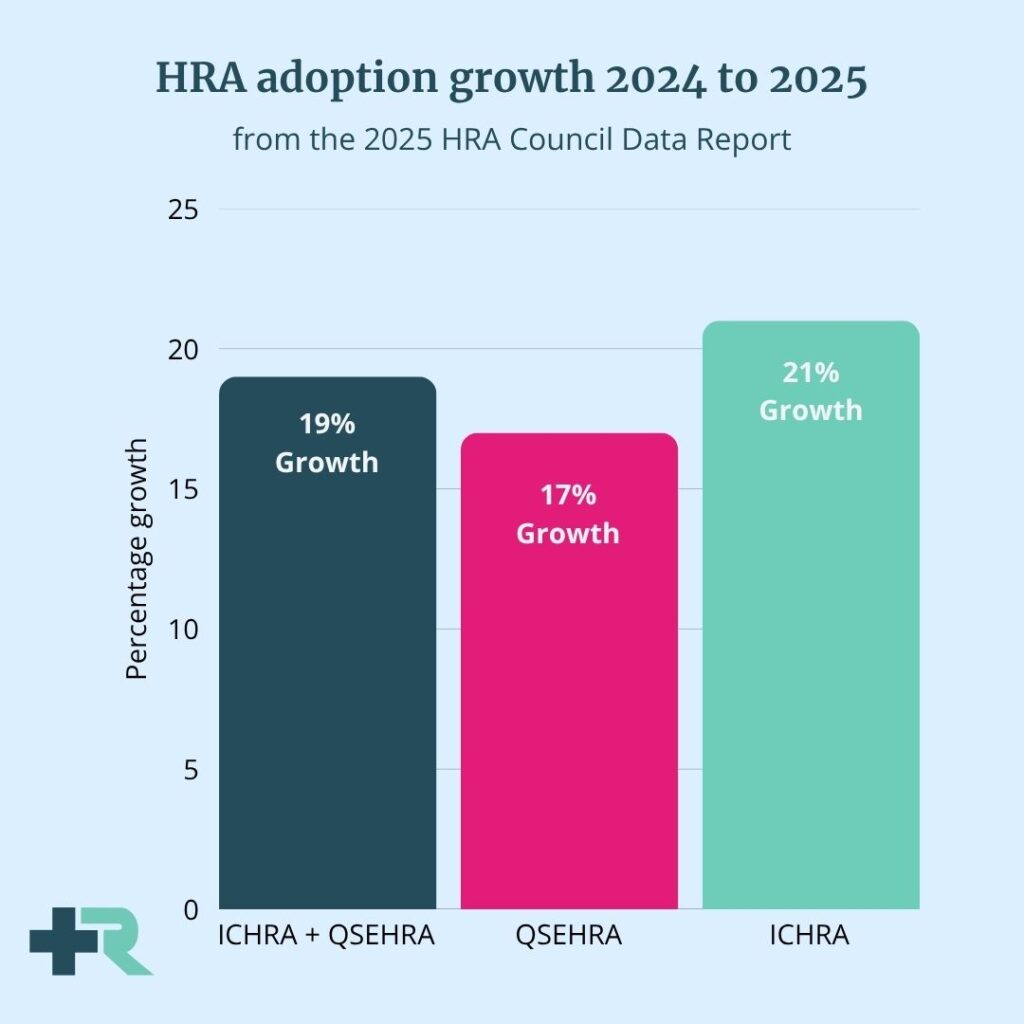
On June 17, 2025, the HRA Council released its 2025 data report, “Growth Trends for ICHRA & QSEHRA, Vol. 4,” offering a comprehensive look at the growth of stand-alone health reimbursement arrangements (HRAs), especially individual coverage HRAs (ICHRAs).
This year’s headline: ICHRA adoption grew 34% among large employers from 2024 to 2025. This growth was driven by a growing number of employers looking for flexible, cost-controlled alternatives to traditional group health plans. Just as notable, 92% of employers who offered an HRA last year continued to do so. This shows that employers are satisfied with the ICHRA and the value it provides to them and their employees.
In this blog post, we’ll examine the HRA Council’s latest findings and provide additional insights based on our customer data featured in the 2024 ICHRA Report.
In this blog post, you’ll learn:
- How much ICHRAs and qualified small employer HRAs (QSEHRAs) grew from 2024 to 2025.
- What a 92% retention rate means for ICHRA’s long-term success.
- Average HRA allowances and which types of individual plans employees select.

Want more insights on the ICHRA? Download our 2024 ICHRA Report.
ICHRA and QSEHRA are growing. Here’s who’s adopting HRAs
The latest HRA Council Data Report shows steady growth in HRA adoption. Combined adoption of ICHRA and QSEHRA grew 19% year-over-year. However, ICHRA is driving more growth than the QSEHRA, with an increase of 21% in the number of employers offering the benefit.

Why ICHRA is outpacing QSEHRA
Both HRAs let employers offer tax-free money to employees for individual health insurance. This gives employers a way to control their benefits budget with more predictable costs. Employees can then choose the individual plans that best fit their needs instead of being forced into a one-size-fits-all group plan.
Unlike QSEHRA, which is only for small businesses with fewer than 50 full-time equivalent employees (FTEs), the ICHRA is available to employers of all sizes. The QSEHRA also has a maximum annual allowance cap. In contrast, employers can offer as much as they’d like with an ICHRA. The ICHRA also has additional customization features, like employee classes. This flexibility makes an ICHRA more attractive for growing organizations and those large enterprise groups looking to rein in healthcare costs.
Small employers are leading, but large employers are catching up
Most employers offering a QSEHRA or ICHRA are non-ALEs. According to the HRA Council, 84% of employers offering an HRA have 20 or fewer employees. This is consistent with the QSEHRA’s limitation and the ICHRA’s appeal for non-ALEs. This stat reveals that an HRA like the ICHRA is a gateway for small businesses that have previously been unable to provide health insurance. This contributes to a decline in the number of uninsured individuals. An HRA can also give small organizations a competitive advantage by helping them attract and retain skilled employees.
But, the adoption of these benefits isn’t confined to small businesses. Once again, applicable large employers (ALEs), those with 50 or more FTEs, are the fastest-growing cohort of employers offering an ICHRA, with a 34% growth trend in the aggregate data. More large and enterprise groups are finding that the ICHRA can help them control costs and promote employee choice. For those with self-funded plans, an ICHRA reduces their risk by moving employees to community-rated individual plans.
Here’s the breakdown of growth in HRA adoption by employer size:
| Employer size | Growth rate |
|---|---|
| 1 – 5 employees | 19% |
| 6 – 20 employees | 10% |
| 21 – 49 employees | 29% |
| 50 – 99 employees | 44% |
| 100 – 199 employees | 49% |
| 200+ employees | 31% |
These numbers show that ICHRA isn’t just a small business solution. Offering an ICHRA can have a strategic advantage across the board. As larger employers continue to look for ways to control benefit costs, ICHRA adoption among this cohort is likely to keep growing.
Employers aren’t just trying HRAs; they’re sticking with them
The HRA Council’s newest data reveals a powerful signal about the staying power of the QSEHRA and ICHRA: about 92% of employers who offered an HRA last year are still offering one in 2025.
While employers may sometimes shop around for a new HRA platform, they’re committed to keeping the type of HRA they prefer. At Remodel Health, we saw this trend firsthand, achieving a 95% net revenue retention rate from 2024 to 2025.
This is an impressive feat in an industry with a much lower retention rate. According to McKinsey’s 2024 Employer Health Benefits Survey1, almost two-thirds of employers were considering switching group health insurance carriers over the next four years. Employers often reassess their options to control costs and meet employee needs.
Maintaining this level of continuity year-over-year shows that HRAs, including the ICHRA, are a meaningful solution to employers who make the switch. These employers see sustained value and aren’t looking to go back to traditional group coverage. For brokers, this means that when you recommend an ICHRA, you’re helping your clients choose a solution they’re likely to stick with.
Unlocking policy potential
This retention trend also creates new opportunities for public policy innovation. If nearly all employers who try HRAs continue to offer them, then even a modest incentive like a short-term tax credit could accelerate adoption.
If ICHRA becomes the CHOICE Arrangement, as proposed by Congress in the 2025 Budget Reconciliation Bill (also known as the “One Big Beautiful Bill Act”), or more states join Indiana in offering a tax credit for employers, it can drive greater adoption. Leveraging an ICHRA and employer tax credits would grow enrollments on the individual market, potentially making a greater impact than renewing the extended premium tax credits alone.
Plans selected by employees and the impact on the ACA Marketplace
The HRA Council also compiled data on the individual health insurance metal levels that employees chose. This information can help employers better understand the types of plans their employees are most likely to choose, which could impact the sort of allowance the employer wants to provide.
Here’s the breakdown of plans reported among HRA Council member customers:
- Bronze: 27.2%
- Silver: 33.7%
- Gold: 35%
- Platinum: 1.6%
- Medicare: 1.8%
- Catastrophic: <1%
Gold plans are the most selected option. With nearly 70% of employees selecting gold or silver plans, this shows that employees are choosing plans that meet their healthcare needs, not just their wallets.
HRAs are growing the individual market
Employees aren’t the only ones enrolling in individual plans. The report found that member organizations had a dependent-to-subscriber ratio of 0.67. This indicates that employees are enrolling in family plans, and adult dependents are also enrolling in individual coverage to take advantage of the HRA. This broader enrollment expands Marketplace participation.
As more healthy individuals join the individual market, the risk pools improve. This stabilizes premium rates. This will become increasingly important should enhanced premium tax credits expire at the end of 2025. The ICHRA could play a stabilizing role in that transition, helping maintain affordability and coverage rates without requiring new subsidies.
Conclusion
The 2025 HRA Council Data Report provides a clear picture of where HRAs like the ICHRA are headed. With continued growth in adoption, high employer retention, and generous allowance trends, HRAs are becoming an essential part of the benefits landscape. With data from 15 member organizations, including Remodel Health, the overall HRA market is likely much larger. Some major ICHRA vendors didn’t contribute to the data report, and the HRA Council estimates that between 500,000 and one million lives are covered by a QSEHRA or ICHRA in 2025.
For employers and brokers, this data confirms that ICHRAs are delivering meaningful results by lowering costs, expanding access to care, and empowering employees to make their own coverage choices.
At Remodel Health, we’re proud to be a contributing member of the HRA Council. As one of the leading ICHRA administrators, we help organizations of all sizes transition away from traditional group plans and toward a more flexible, cost-effective benefits model.

Want to see more data? Get the HRA Council’s full report.
Sources:
